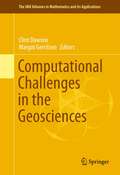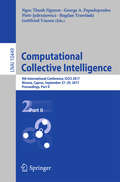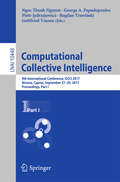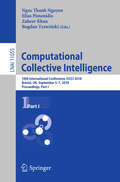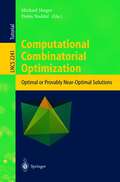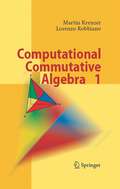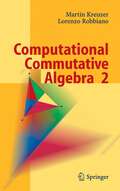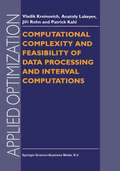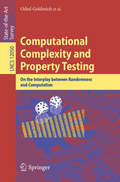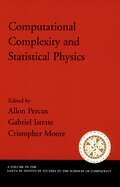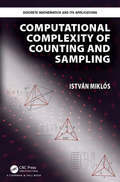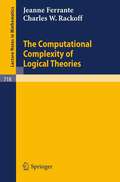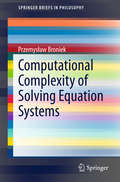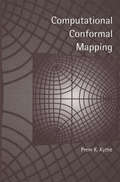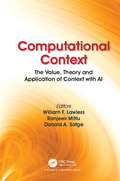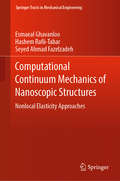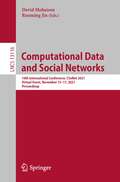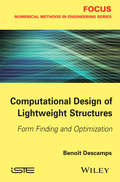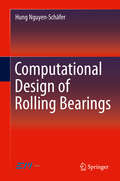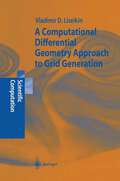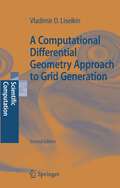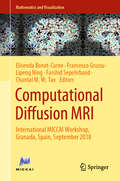- Table View
- List View
Computational Challenges in the Geosciences (The IMA Volumes in Mathematics and its Applications #156)
by Clint Dawson and Margot GerritsenComputational Challenges in the Geosciences addresses a cross-section of grand challenge problems arising in geoscience applications, including groundwater and petroleum reservoir simulation, hurricane storm surge, oceanography, volcanic eruptions and landslides, and tsunamis. Each of these applications gives rise to complex physical and mathematical models spanning multiple space-time scales, which can only be studied through computer simulation. The data required by the models is often highly uncertain, and the numerical solution of the models requires sophisticated algorithms which are mathematically accurate, computationally efficient and yet must preserve basic physical properties of the models. This volume summarizes current methodologies and future research challenges in this broad and important field.
Computational Collective Intelligence: 9th International Conference, ICCCI 2017, Nicosia, Cyprus, September 27-29, 2017, Proceedings, Part II (Lecture Notes in Computer Science #10449)
by Ngoc Thanh Nguyen George A. Papadopoulos Piotr Jędrzejowicz Bogdan Trawiński Gottfried VossenThis two-volume set (LNAI 10448 and LNAI 10449) constitutes the refereed proceedings of the 9th International Conference on Collective Intelligence, ICCCI 2017, held in Nicosia, Cyprus, in September 2017. The 117 full papers presented were carefully reviewed and selected from 248 submissions. The conference focuseson the methodology and applications of computational collective intelligence, included: multi-agent systems, knowledge engineering and semantic web, social networks and recommender systems, text processing and information retrieval, data mining methods and applications, sensor networks and internet of things, decision support & control systems, and computer vision techniques.
Computational Collective Intelligence: 9th International Conference, ICCCI 2017, Nicosia, Cyprus, September 27-29, 2017, Proceedings, Part I (Lecture Notes in Computer Science #10448)
by Ngoc Thanh Nguyen George A. Papadopoulos Piotr Jędrzejowicz Bogdan Trawiński Gottfried VossenThis two-volume set (LNAI 10448 and LNAI 10449) constitutes the refereed proceedings of the 9th International Conference on Collective Intelligence, ICCCI 2017, held in Nicosia, Cyprus, in September 2017. The 117 full papers presented were carefully reviewed and selected from 248 submissions. The conference focuseson the methodology and applications of computational collective intelligence, included: multi-agent systems, knowledge engineering and semantic web, social networks and recommender systems, text processing and information retrieval, data mining methods and applications, sensor networks and internet of things, decision support & control systems, and computer vision techniques.
Computational Collective Intelligence: 10th International Conference, ICCCI 2018, Bristol, UK, September 5-7, 2018, Proceedings, Part I (Lecture Notes in Computer Science #11055)
by Ngoc Thanh Nguyen Elias Pimenidis Zaheer Khan Bogdan TrawińskiThis two-volume set (LNAI 11055 and LNAI 11056) constitutes the refereed proceedings of the 10th International Conference on Collective Intelligence, ICCCI 2018, held in Bristol, UK, in September 2018 The 98 full papers presented were carefully reviewed and selected from 240 submissions. The conference focuses on knowledge engineering and semantic web, social network analysis, recommendation methods and recommender systems, agents and multi-agent systems, text processing and information retrieval, data mining methods and applications, decision support and control systems, sensor networks and internet of things, as well as computer vision techniques.
Computational Combinatorial Optimization: Optimal or Provably Near-Optimal Solutions (Lecture Notes in Computer Science #2241)
by Michael Jünger Denis NaddefThis tutorial contains written versions of seven lectures on Computational Combinatorial Optimization given by leading members of the optimization community. The lectures introduce modern combinatorial optimization techniques, with an emphasis on branch and cut algorithms and Lagrangian relaxation approaches. Polyhedral combinatorics as the mathematical backbone of successful algorithms are covered from many perspectives, in particular, polyhedral projection and lifting techniques and the importance of modeling are extensively discussed. Applications to prominent combinatorial optimization problems, e.g., in production and transport planning, are treated in many places; in particular, the book contains a state-of-the-art account of the most successful techniques for solving the traveling salesman problem to optimality.
Computational Commutative Algebra 1
by Martin Kreuzer Lorenzo RobbianoThis introduction to polynomial rings, Gröbner bases and applications bridges the gap in the literature between theory and actual computation. It details numerous applications, covering fields as disparate as algebraic geometry and financial markets. To aid in a full understanding of these applications, more than 40 tutorials illustrate how the theory can be used. The book also includes many exercises, both theoretical and practical.
Computational Commutative Algebra 2
by Martin Kreuzer Lorenzo Robbiano"The second volume of the authors’ ‘Computational commutative algebra’…covers on its 586 pages a wealth of interesting material with several unexpected applications. … an encyclopedia on computational commutative algebra, a source for lectures on the subject as well as an inspiration for seminars. The text is recommended for all those who want to learn and enjoy an algebraic tool that becomes more and more relevant to different fields of applications." --ZENTRALBLATT MATH
Computational Complexity and Feasibility of Data Processing and Interval Computations (Applied Optimization #10)
by V. Kreinovich A.V. Lakeyev J. Rohn P.T. KahlTargeted audience • Specialists in numerical computations, especially in numerical optimiza tion, who are interested in designing algorithms with automatie result ver ification, and who would therefore be interested in knowing how general their algorithms caIi in principle be. • Mathematicians and computer scientists who are interested in the theory 0/ computing and computational complexity, especially computational com plexity of numerical computations. • Students in applied mathematics and computer science who are interested in computational complexity of different numerical methods and in learning general techniques for estimating this computational complexity. The book is written with all explanations and definitions added, so that it can be used as a graduate level textbook. What this book .is about Data processing. In many real-life situations, we are interested in the value of a physical quantity y that is diflicult (or even impossible) to measure directly. For example, it is impossible to directly measure the amount of oil in an oil field or a distance to a star. Since we cannot measure such quantities directly, we measure them indirectly, by measuring some other quantities Xi and using the known relation between y and Xi'S to reconstruct y. The algorithm that transforms the results Xi of measuring Xi into an estimate fj for y is called data processing.
Computational Complexity and Property Testing: On the Interplay Between Randomness and Computation (Lecture Notes in Computer Science #12050)
by Itai Benjamini Scott Decatur Maya Leshkowitz Or Meir Dana Ron Guy Rothblum Avishay Tal Liav Teichner Roei Tell Avi WigdersonThis volume contains a collection of studies in the areas of complexity theory and property testing. The 21 pieces of scientific work included were conducted at different times, mostly during the last decade. Although most of these works have been cited in the literature, none of them was formally published before. Within complexity theory the topics include constant-depth Boolean circuits, explicit construction of expander graphs, interactive proof systems, monotone formulae for majority, probabilistically checkable proofs (PCPs), pseudorandomness, worst-case to average-case reductions, and zero-knowledge proofs.Within property testing the topics include distribution testing, linearity testing, lower bounds on the query complexity (of property testing), testing graph properties, and tolerant testing. A common theme in this collection is the interplay between randomness and computation.
Computational Complexity and Statistical Physics (Santa Fe Institute Studies on the Sciences of Complexity)
by Allon Percus Gabriel Istrate Cristopher MooreComputer science and physics have been closely linked since the birth of modern computing. In recent years, an interdisciplinary area has blossomed at the junction of these fields, connecting insights from statistical physics with basic computational challenges. Researchers have successfully applied techniques from the study of phase transitions to analyze NP-complete problems such as satisfiability and graph coloring. This is leading to a new understanding of the structure of these problems, and of how algorithms perform on them. Computational Complexity and Statistical Physics will serve as a standard reference and pedagogical aid to statistical physics methods in computer science, with a particular focus on phase transitions in combinatorial problems. Addressed to a broad range of readers, the book includes substantial background material along with current research by leading computer scientists, mathematicians, and physicists. It will prepare students and researchers from all of these fields to contribute to this exciting area.
Computational Complexity of Counting and Sampling (Discrete Mathematics and Its Applications)
by Istvan MiklosComputational Complexity of Counting and Sampling provides readers with comprehensive and detailed coverage of the subject of computational complexity. It is primarily geared toward researchers in enumerative combinatorics, discrete mathematics, and theoretical computer science. The book covers the following topics: Counting and sampling problems that are solvable in polynomial running time, including holographic algorithms; #P-complete counting problems; and approximation algorithms for counting and sampling. First, it opens with the basics, such as the theoretical computer science background and dynamic programming algorithms. Later, the book expands its scope to focus on advanced topics, like stochastic approximations of counting discrete mathematical objects and holographic algorithms. After finishing the book, readers will agree that the subject is well covered, as the book starts with the basics and gradually explores the more complex aspects of the topic. Features: Each chapter includes exercises and solutions Ideally written for researchers and scientists Covers all aspects of the topic, beginning with a solid introduction, before shifting to computational complexity’s more advanced features, with a focus on counting and sampling
Computational Complexity of Counting and Sampling (Discrete Mathematics and Its Applications)
by Istvan MiklosComputational Complexity of Counting and Sampling provides readers with comprehensive and detailed coverage of the subject of computational complexity. It is primarily geared toward researchers in enumerative combinatorics, discrete mathematics, and theoretical computer science. The book covers the following topics: Counting and sampling problems that are solvable in polynomial running time, including holographic algorithms; #P-complete counting problems; and approximation algorithms for counting and sampling. First, it opens with the basics, such as the theoretical computer science background and dynamic programming algorithms. Later, the book expands its scope to focus on advanced topics, like stochastic approximations of counting discrete mathematical objects and holographic algorithms. After finishing the book, readers will agree that the subject is well covered, as the book starts with the basics and gradually explores the more complex aspects of the topic. Features: Each chapter includes exercises and solutions Ideally written for researchers and scientists Covers all aspects of the topic, beginning with a solid introduction, before shifting to computational complexity’s more advanced features, with a focus on counting and sampling
The Computational Complexity of Logical Theories (Lecture Notes in Mathematics #718)
by J. Ferrante C. W. RackoffComputational Complexity of Solving Equation Systems (SpringerBriefs in Philosophy)
by Przemysław BroniekThis volume considers the computational complexity of determining whether a system of equations over a fixed algebra A has a solution. It examines in detail the two problems this leads to: SysTermSat(A) and SysPolSat(A), in which equations are built out of terms or polynomials, respectively. The book characterizes those algebras for which SysPolSat can be solved in a polynomial time. So far, studies and their outcomes have not covered algebras that generate a variety admitting type 1 in the sense of Tame Congruence Theory. Since unary algebras admit only type 1, this book focuses on these algebras to tackle the main problem. It discusses several aspects of unary algebras and proves that the Constraint Satisfaction Problem for relational structures is polynomially equivalent to SysTermSat over unary algebras. The book’s final chapters discuss partial characterizations, present conclusions, and describe the problems that are still open.
Computational Context: The Value, Theory and Application of Context with AI
by William F. Lawless Ranjeev Mittu Donald SofgeThis volume addresses context from three comprehensive perspectives: first, its importance, the issues surrounding context, and its value in the laboratory and the field; second, the theory guiding the AI used to model its context; and third, its applications in the field (e.g., decision-making). This breadth poses a challenge. The book analyzes how the environment (context) influences human perception, cognition and action. While current books approach context narrowly, the major contribution of this book is to provide an in-depth review over a broad range of topics for a computational context no matter its breadth. The volume outlines numerous strategies and techniques from world-class scientists who have adapted their research to solve different problems with AI, in difficult environments and complex domains to address the many computational challenges posed by context. Context can be clear, uncertain or an illusion. Clear contexts: A father praising his child; a trip to the post office to buy stamps; a policewoman asking for identification. Uncertain contexts: A sneak attack; a surprise witness in a courtroom; a shout of "Fire! Fire!" Contexts as illusion: Humans fall prey to illusions that machines do not (Adelson’s checkerboard illusion versus a photometer). Determining context is not easy when disagreement exists, interpretations vary, or uncertainty reigns. Physicists like Einstein (relativity), Bekenstein (holographs) and Rovelli (universe) have written that reality is not what we commonly believe. Even outside of awareness, individuals act differently whether alone or in teams. Can computational context with AI adapt to clear and uncertain contexts, to change over time, and to individuals, machines or robots as well as to teams? If a program automatically "knows" the context that improves performance or decisions, does it matter whether context is clear, uncertain or illusory? Written and edited by world class leaders from across the field of autonomous systems research, this volume carefully considers the computational systems being constructed to determine context for individual agents or teams, the challenges they face, and the advances they expect for the science of context.
Computational Context: The Value, Theory and Application of Context with AI
by William F. Lawless Ranjeev Mittu Donald SofgeThis volume addresses context from three comprehensive perspectives: first, its importance, the issues surrounding context, and its value in the laboratory and the field; second, the theory guiding the AI used to model its context; and third, its applications in the field (e.g., decision-making). This breadth poses a challenge. The book analyzes how the environment (context) influences human perception, cognition and action. While current books approach context narrowly, the major contribution of this book is to provide an in-depth review over a broad range of topics for a computational context no matter its breadth. The volume outlines numerous strategies and techniques from world-class scientists who have adapted their research to solve different problems with AI, in difficult environments and complex domains to address the many computational challenges posed by context. Context can be clear, uncertain or an illusion. Clear contexts: A father praising his child; a trip to the post office to buy stamps; a policewoman asking for identification. Uncertain contexts: A sneak attack; a surprise witness in a courtroom; a shout of "Fire! Fire!" Contexts as illusion: Humans fall prey to illusions that machines do not (Adelson’s checkerboard illusion versus a photometer). Determining context is not easy when disagreement exists, interpretations vary, or uncertainty reigns. Physicists like Einstein (relativity), Bekenstein (holographs) and Rovelli (universe) have written that reality is not what we commonly believe. Even outside of awareness, individuals act differently whether alone or in teams. Can computational context with AI adapt to clear and uncertain contexts, to change over time, and to individuals, machines or robots as well as to teams? If a program automatically "knows" the context that improves performance or decisions, does it matter whether context is clear, uncertain or illusory? Written and edited by world class leaders from across the field of autonomous systems research, this volume carefully considers the computational systems being constructed to determine context for individual agents or teams, the challenges they face, and the advances they expect for the science of context.
Computational Continuum Mechanics of Nanoscopic Structures: Nonlocal Elasticity Approaches (Springer Tracts in Mechanical Engineering)
by Esmaeal Ghavanloo Hashem Rafii-Tabar Seyed Ahmad FazelzadehThis book offers a comprehensive treatment of nonlocal elasticity theory as applied to the prediction of the mechanical characteristics of various types of biological and non-biological nanoscopic structures with different morphologies and functional behaviour. It combines fundamental notions and advanced concepts, covering both the theory of nonlocal elasticity and the mechanics of nanoscopic structures and systems. By reporting on recent findings and discussing future challenges, the book seeks to foster the application of nonlocal elasticity based approaches to the emerging fields of nanoscience and nanotechnology. It is a self-contained guide, and covers all relevant background information, the requisite mathematical and computational techniques, theoretical assumptions, physical methods and possible limitations of the nonlocal approach, including some practical applications. Mainly written for researchers in the fields of physics, biophysics, mechanics, and nanoscience, as well as computational engineers, the book can also be used as a reference guide for senior undergraduate and graduate students, as well as practicing engineers working in a range of areas, such as computational condensed matter physics, computational materials science, computational nanoscience and nanotechnology, and nanomechanics.
Computational Data and Social Networks: 10th International Conference, CSoNet 2021, Virtual Event, November 15–17, 2021, Proceedings (Lecture Notes in Computer Science #13116)
by David Mohaisen Ruoming JinThis book constitutes the refereed proceedings of the 10th International Conference on Computational Data and Social Networks, CSoNet 2021, which was held online during November 15-17, 2021. The conference was initially planned to take place in Montreal, Quebec, Canada, but changed to an online event due to the COVID-19 pandemic. The 24 full and 8 short papers included in this book were carefully reviewed and selected from 57 submissions. They were organized in topical sections as follows: Combinatorial optimization and learning; deep learning and applications to complex and social systems; measurements of insight from data; complex networks analytics; special track on fact-checking, fake news and malware detection in online social networks; and special track on information spread in social and data networks.
Computational Design of Lightweight Structures: Form Finding and Optimization
by Benoit DescampsThe author of this book presents a general, robust, and easy-to-use method that can handle many design parameters efficiently.Following an introduction, Chapter 1 presents the general concepts of truss layout optimization, starting from topology optimization where structural component sizes and system connectivity are simultaneously optimized. To fully realize the potential of truss layout optimization for the design of lightweight structures, the consideration of geometrical variables is then introduced.Chapter 2 addresses truss geometry and topology optimization by combining mathematical programming and structural mechanics: the structural properties of the optimal solution are used for devising the novel formulation. To avoid singularities arising in optimal configurations, this approach disaggregates the equilibrium equations and fully integrates their basic elements within the optimization formulation. The resulting tool incorporates elastic and plastic design, stress and displacement constraints, as well as self-weight and multiple loading. The inherent slenderness of lightweight structures requires the study of stability issues.As a remedy, Chapter 3 proposes a conceptually simple but efficient method to include local and nodal stability constraints in the formulation. Several numerical examples illustrate the impact of stability considerations on the optimal design.Finally, the investigation on realistic design problems in Chapter 4 confirms the practical applicability of the proposed method. It is shown how we can generate a range of optimal designs by varying design settings.
Computational Design of Lightweight Structures: Form Finding and Optimization
by Benoit DescampsThe author of this book presents a general, robust, and easy-to-use method that can handle many design parameters efficiently.Following an introduction, Chapter 1 presents the general concepts of truss layout optimization, starting from topology optimization where structural component sizes and system connectivity are simultaneously optimized. To fully realize the potential of truss layout optimization for the design of lightweight structures, the consideration of geometrical variables is then introduced.Chapter 2 addresses truss geometry and topology optimization by combining mathematical programming and structural mechanics: the structural properties of the optimal solution are used for devising the novel formulation. To avoid singularities arising in optimal configurations, this approach disaggregates the equilibrium equations and fully integrates their basic elements within the optimization formulation. The resulting tool incorporates elastic and plastic design, stress and displacement constraints, as well as self-weight and multiple loading. The inherent slenderness of lightweight structures requires the study of stability issues.As a remedy, Chapter 3 proposes a conceptually simple but efficient method to include local and nodal stability constraints in the formulation. Several numerical examples illustrate the impact of stability considerations on the optimal design.Finally, the investigation on realistic design problems in Chapter 4 confirms the practical applicability of the proposed method. It is shown how we can generate a range of optimal designs by varying design settings.
Computational Design of Rolling Bearings
by Hung Nguyen-SchäferThis book comprehensively presents the computational design of rolling bearings dealing with many interdisciplinary difficult working fields. They encompass elastohydrodynamics (EHD), Hertzian contact theory, oil-film thickness in elastohydrodynamic lubrication (EHL), bearing dynamics, tribology of surface textures, fatigue failure mechanisms, fatigue lifetimes of rolling bearings and lubricating greases, Weibull distribution, rotor balancing, and airborne noises (NVH) in the rolling bearings. Furthermore, the readers are provided with hands-on essential formulas based on the up-to-date DIN ISO norms and helpful examples for computational design of rolling bearings. The topics are intended for undergraduate and graduate students in mechanical and material engineering, research scientists, and practicing engineers who want to understand the interactions between these working fields and to know how to design the rolling bearings for automotive industry and many other industries.
A Computational Differential Geometry Approach to Grid Generation (Scientific Computation)
by Vladimir D. LiseikinThe process of breaking up a physical domain into smaller sub-domains, known as meshing, facilitates the numerical solution of partial differential equations used to simulate physical systems. In an updated and expanded Second Edition, this monograph gives a detailed treatment based on the numerical solution of inverted Beltramian and diffusion equations with respect to monitor metrics for generating both structured and unstructured grids in domains and on surfaces.
A Computational Differential Geometry Approach to Grid Generation (Scientific Computation)
by Vladimir D. LiseikinThe process of breaking up a physical domain into smaller sub-domains, known as meshing, facilitates the numerical solution of partial differential equations used to simulate physical systems. In an updated and expanded Second Edition, this monograph gives a detailed treatment based on the numerical solution of inverted Beltramian and diffusion equations with respect to monitor metrics for generating both structured and unstructured grids in domains and on surfaces.
Computational Diffusion MRI: International MICCAI Workshop, Granada, Spain, September 2018 (Mathematics and Visualization)
by Elisenda Bonet-Carne Francesco Grussu Lipeng Ning Farshid Sepehrband Chantal M. W. TaxThis volume gathers papers presented at the Workshop on Computational Diffusion MRI (CDMRI’18), which was held under the auspices of the International Conference on Medical Image Computing and Computer Assisted Intervention in Granada, Spain on September 20, 2018. It presents the latest developments in the highly active and rapidly growing field of diffusion MRI. The reader will find papers on a broad range of topics, from the mathematical foundations of the diffusion process and signal generation, to new computational methods and estimation techniques for the in-vivo recovery of microstructural and connectivity features, as well as harmonisation and frontline applications in research and clinical practice. The respective papers constitute invited works from high-profile researchers with a specific focus on three topics that are now gaining momentum within the diffusion MRI community: i) machine learning for diffusion MRI; ii) diffusion MRI outside the brain (e.g. in the placenta); and iii) diffusion MRI for multimodal imaging. The book shares new perspectives on the latest research challenges for those currently working in the field, but also offers a valuable starting point for anyone interested in learning computational techniques in diffusion MRI. It includes rigorous mathematical derivations, a wealth of full-colour visualisations, and clinically relevant results. As such, it will be of interest to researchers and practitioners in the fields of computer science, MRI physics and applied mathematics alike.
